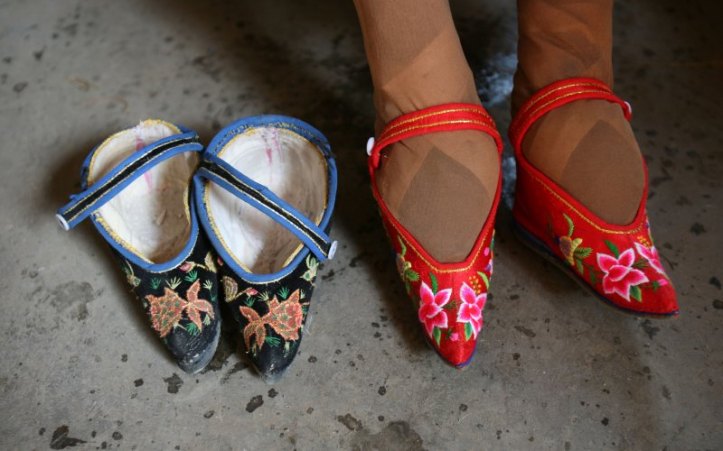Synopsis (Images at Bottom) (via):
Several stories exist as to how the practice got started, but the most popular and credible says it began with Emperor Li Yu, who reigned during the Southern Tang dynasty (937-975 A.D.). In 970, the emperor reportedly saw his favorite consort dancing on a golden lotus pedestal and was entranced by her feet, which she had wrapped in strips of cloth — much like those of a ballerina dancing on pointe — so her dancing appeared more beautiful. Seeing the emperor’s pleasure, other court maidens similarly wrapped their feet. Soon upper-class women adopted the fashion, and eventually it spread to all women, no matter their social status. Only a few regions resisted, like the Manchu and those who hailed from Guangdong in southern China [sources: Holman, Ross].
Unfortunately, as the custom took hold it morphed. Women wanted ever-smaller, more curved feet, and so the foot binding process was created to achieve highly arched, 3-inch (7.6-centimeter) feet. The practice thrived for 1,000 years until it was outlawed in 1912 after the revolution of Sun Yat-sen. However, women continued to bind their feet in parts of China until the late 1950s [sources: Evans, Minnesota-China Connection].
The foot binding process was long, excruciatingly painful and pretty gross. It generally began when girls were 4 to 7 years old, because at that age the bones in their feet were still fairly soft and pliable, and thus easier to reshape .
First, the feet were softened in hot water. After a few hours, any dead skin was scrubbed off, toenails were clipped as short as possible and alum was sprinkled between the toes to stop perspiration. Next came the actual binding. Cotton bandages, generally 2 inches (5 centimeters) wide by 10 feet (3 meters) long, were soaked in hot water so they’d shrink as they dried. Then the binder — sometimes the girl’s mother, other times an experienced woman in the village — folded the girl’s four small toes under her feet and began wrapping each foot with the bandages in a figure-eight pattern. The goal was to leave the big toe and ball of the foot largely intact, but keep the other four toes under the foot and bring the heel forward, towards the front of the foot. The bones in the arch and foot would break during the process. To ensure a tight bind and prevent the little girl from ripping off the bandages, the bandages were sewn together at several points. Once the binding was finished, a small pair of shoes was placed on the girl’s feet and she was forced to walk around. The initial steps taken when feet were bound were incredibly painful .
Every day or two, the girl’s feet were unbound, bathed and rebound. Slowly, the bindings became tighter and the shoes smaller, until her feet reached the coveted 3-inch crescent moon shape, a process that took about two years .
Once foot binding became entrenched in the culture, it was impossible to stop. Bound feet became the norm; unbound feet were seen as freakish, lewd and ugly. And while mothers undoubtedly hated to inflict pain on their daughters, leaving their feet unbound was never considered. For if a mother didn’t bind her daughter’s feet, her daughter would be ridiculed by other women and would almost assuredly never snag a husband. A young girl could be lifted out of poverty if her feet were small and perfectly curved, because that was more important to men than her social status .
Foot binding also fostered the dominance of men over women. Since it was difficult for a woman to walk with bound feet — the farthest she could walk was 3 or 4 miles (4.8 to 6.4 kilometers) — Chinese women never strayed far from home, nor had much contact with others outside their villages. This made them more conservative and more willing to obey their husbands. Their diminished mobility virtually ensured they couldn’t have extramarital affairs, or run away to escape a beating when their husbands were displeased. As foot binding became entrenched during the Song dynasty (960-1279), education for women was strictly curtailed and independent property rights outlawed [sources: Evans, Ross, Holman].
On a more positive note, foot binding also created strong intergenerational bonds among the women, since they did all the binding and also had their feet bound. Women were proud of their tiny feet. They regularly got together to sew their shoes, which were a major fashion statement .
Beyond relationships, foot binding reshaped China’s architecture. The Chinese began building only single-story homes because it was so difficult for women to climb stairs. Streets and lanes were very narrow because the women needed to lean upon walls or railings when they walked .







